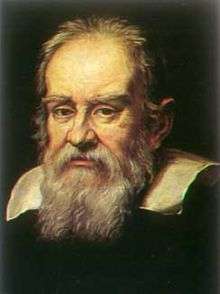Lamp At Midnight
Lamp At Midnight is a play that was written by Barrie Stavis,[1] and first produced in 1947 at New Stages, New York.[2] The play treats the 17th Century Galileo affair, which was a profound conflict between the Roman Catholic Church and Galileo Galilei over the interpretation of his astronomical observations using the newly invented telescope. By coincidence, Bertolt Brecht's play on the same theme, Galileo, opened in New York just a few weeks before Lamp at Midnight. Some critics now consider Galileo to be a masterpiece,[3] but in 1947 the New York Times reviewer, Brooks Atkinson, preferred Lamp at Midnight.[2][4]
A revival of Lamp at Midnight directed by Sir Tyrone Guthrie and starring Morris Carnovsky toured the United States in 1969.[5]
Adaptation for television
| Lamp at Midnight | |
|---|---|
| Directed by | George Schaefer |
| Screenplay by | Robert Hartung |
| Based on |
Lamp at Midnight by Barrie Stavis |
| Starring |
Melvyn Douglas Kim Hunter Hurd Hatfield William Kerwin |
| Music by | Bernard Green |
Release dates | 1966 |
Running time | 76 minutes |
| Country | United States |
| Language | English |
A television adaptation, directed by George Schaefer and starring Melvyn Douglas as Galileo, appeared in the Hallmark Hall of Fame series in 1966.[6][7] A recording of the television performance was released to video in 1983.[8]
References
- ↑ Stavis, Barrie (1948). Lamp at Midnight: A Play in Three Acts. Dramatists Play Service. OCLC 3067032.
- 1 2 Atkinson, Brooks (December 22, 1947). "At the Theater". The New York Times. (subscription required (help)).
It is a deeply moving play with a passionate theme and a resolute point of view.
- ↑ Billington, Michael (February 13, 2013). "A Life of Galileo – review". The Guardian.
the real pleasure of Roxana Silbert's modern-dress RSC revival and Mark Ravenhill's slimmed-down translation lies in the absolute clarity with which they put Brecht's masterpiece before us.
- ↑ Mitchell, Richard W. (2003). Brecht in L.A.: A Play. Intellect Books. p. 168. ISBN 9781841501055.
In Los Angeles, Brecht worked for several years with Laughton on an English translation/adaptation, Galileo, which opened in 1947 in Los Angeles and then on Broadway with Laughton playing the title role. The American productions, directed by Joseph Losey (with a great deal of input from Brecht), received mixed reviews in Los Angeles and harsher reviews in New York, where the production met with less success than another play about Galileo, The Lamp at Midnight, by Barrie Stavis, which opened two weeks after Brecht's play.
- ↑ "'Lamp at Midnight' to Star Carnovsky". The New York Times. June 14, 1968. (subscription required (help)).
- ↑ Gould, Jack (April 28, 1966). "TV: Static View of Galileo's Ordeal". The New York Times. (subscription required (help)).
It was an hour of interesting storytelling, but hardly stimulating theater.
- ↑ Erickson, Hal. "Lamp at Midnight (1966)". allmovie.
- ↑ Lamp at Midnight (VHS). Films for the Humanities. 1983. OCLC 11689040.
Further reading
- Larson, David Ward (1989). The Galileo plays of Bertolt Brecht and Barrie Stavis (Ph.D.). University of Illinois at Urbana Champaign. OCLC 774712848. Doctoral thesis that compares Lamp at Midnight with Bertolt Brecht's play, Galileo.
- Murphy, Brenda (2003). Congressional Theatre: Dramatizing McCarthyism on Stage, Film, and Television. Cambridge University Press. p. 199. ISBN 9780521891660.
Although producer-director George Schaefer was willing to defy the blacklist in casting the production, he was more careful about offending the Church.
Discussion of the reception of Stavis' play in 1947 and the production of the television adaptation in 1966. Both Melvyn Douglas and Kim Hunter, stars of the 1966 television production, had few opportunities for film and television work through the 1950s as a consequence of the Hollywood blacklist.
